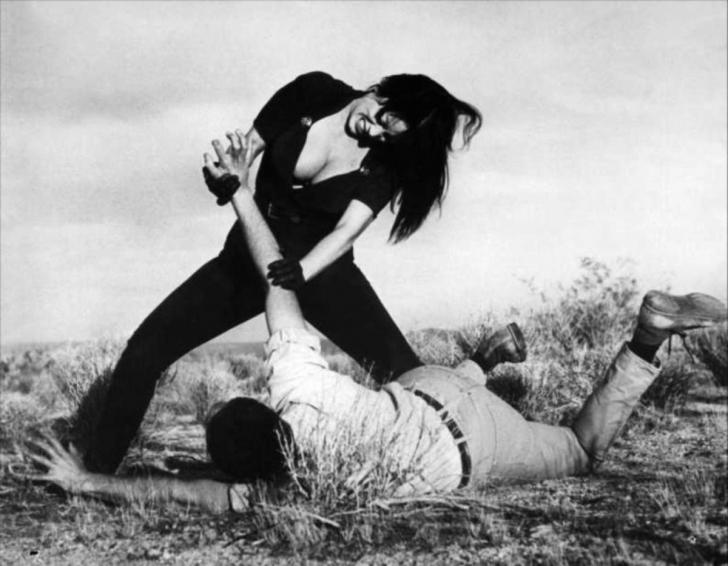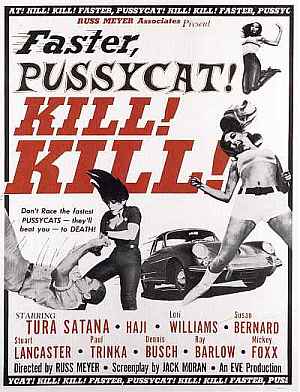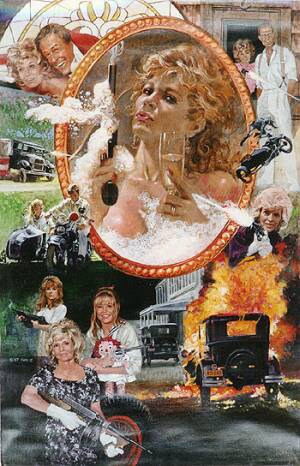 ★★★★★
★★★★★
“The Smell of Female”
“Ladies and Gentlemen, welcome to Violence. The word and the act. While violence cloaks itself in a plethora of disguises, its favourite mantle still remains – sex. Violence devours all it touches, its voracious appetite rarely fulfilled. Yet violence doesn’t only destroy. It creates and moulds as well. Let’s examine closely then this dangerously evil creation, this new breed encased and contained within the supple skin of woman. The softness is there, the unmistakeable smell of female. the surface shiny and silken. The body yielding yet wanton. But a word of caution: handle with care and don’t drop your guard. This rapacious new breed prowls both alone and in packs. Operating at any level, at any time, anywhere and with anybody. Who are they? One might be your secretary, your doctor’s receptionist, or a dancer in a go-go club!”

 Made more than forty years ago, Faster was decades ahead of its time – which may explain why it was such a resounding flop on initial release. But in his autobiography, John Waters called it, “The best movie ever made, and possibly better than any movie that will ever be made,” and helped resurrect it: Rob Zombie is another big fan, and introduced its recent screening on – of all places! – Turner Classic Movies. For this is the kind of film, hell, the kind of title, Quentin Tarantino wishes in his wet dreams he could create. And yet, it’s also an interesting example of censorship as artistically productive: probably the tamest of Meyer’s films: subsequently (and, often, before) they would contain a great deal more explicit nudity. But very rarely did he ever come close to the same artistic heights.
Made more than forty years ago, Faster was decades ahead of its time – which may explain why it was such a resounding flop on initial release. But in his autobiography, John Waters called it, “The best movie ever made, and possibly better than any movie that will ever be made,” and helped resurrect it: Rob Zombie is another big fan, and introduced its recent screening on – of all places! – Turner Classic Movies. For this is the kind of film, hell, the kind of title, Quentin Tarantino wishes in his wet dreams he could create. And yet, it’s also an interesting example of censorship as artistically productive: probably the tamest of Meyer’s films: subsequently (and, often, before) they would contain a great deal more explicit nudity. But very rarely did he ever come close to the same artistic heights.
It tells the story of three girls: go-go dancers, hot-rod racers and outlaws, led by Varla (Satana). One afternoon, their chilling in the desert is rudely interrupted by Tommy and Linda (Bernard, who’d become a Playboy centerfold in 1966), a “square” couple who also have a car. After racing against them, Tommy and Varla get into a fight, which ends with Varla snapping his back. The trio kidnap Linda, and drive off. Stopping to get gas, they hear from the attendant about a crippled old man, who lives with his two sons, and is rumoured to have a fortune as the result of an accident. The girls decide to pay him a visit, and relieve him of his money – only to find out that he may be even more twisted and sadistic than they are…
Where to start? What about with the dialogue, which is prime, ripe and firm as last year’s Gouda, even if Satana has a slightly-irritating tendency to belt out every line at the top of her lungs. But as Rosie (Haji) says, “Honey, we don’t like nothin’ soft! Everything we touch is hard!” – these broads are “like a velvet glove, cast in iron,” as another memorable line reports. Or, as Varla puts it, “I never try anything. I just do it.” Almost every line has a sneer attached to it, and while none of the actresses went on to do anything else of real significance, they are all perfect here. They’re obviously playing characters, but their characters are also playing characters, so it all ties together with either remarkable happenstance, or artistic genius.
 Often neglected are the male contributors, in particular Stuart Lancaster as the target of their scheme. Though confined to a wheelchair, he rules his twisted clan with a rod of iron; in many ways, this is an ancestor of the family from Texas Chainsaw Massacre, with ‘the vegetable’ – as even his own father refers to him – a kinder, gentler version of Leatherface. Seeing the old man slobbering over Linda certainly shifts the audience, and helps to turn the murderous Varla and the other girls from villains into heroines, even as they progress their plan of robbery, because you sense their fate could end up being worse than death.
Often neglected are the male contributors, in particular Stuart Lancaster as the target of their scheme. Though confined to a wheelchair, he rules his twisted clan with a rod of iron; in many ways, this is an ancestor of the family from Texas Chainsaw Massacre, with ‘the vegetable’ – as even his own father refers to him – a kinder, gentler version of Leatherface. Seeing the old man slobbering over Linda certainly shifts the audience, and helps to turn the murderous Varla and the other girls from villains into heroines, even as they progress their plan of robbery, because you sense their fate could end up being worse than death.
Rarely have all the aspects of a film come together with such perfection: it’s like throwing a dozen die and watching them all come up sixes. The editing; the script; the casting; the performances; the theme-tune alone is one of the best of the decade, and all the music helps drive the film along at a relentless pace. You could argue that it’s all idiotically unrealistic, and I would be hard-pushed to disagree. But I would, however, counter that this is much of the film’s appeal: it takes place in an alternate universe ruled by large-breasted, leather-clad, superwomen. Speaking personally, that may not be somewhere I’d want to live, but boy, it sounds like a fun place to visit. :-)
A militant feminist a decade before feminism was popular, Varla is also among the first openly bisexual women in cinema history, and the film is remarkably unjudgemental about the sexuality of any of the women. This helps explain why the movie’s cult appeal crosses so many boundaries, from the gay community to hardcore punk. And though they’re nothing to raise eyebrows today, Satana also used martial arts when they were almost unheard of in Hollywood. It’s sardonic, trailer-trash chic from an era that had yet to grasp fully the entertainment value of such irony. Others would aim at the same targets subsequently, mixing sex with violence in various ratios (Barbarella, Danger: Diabolik, The Perils of Gwendoline), but even now, few have come closer to capturing the heady, hyper-kinetic approach of Meyer’s finest work.
Dir: Russ Meyer
Stars: Tura Satana, Lori Williams, Haji, Sue Bernard





 A Roger Corman production. Those four words cover much turf, both good and bad; this inclines toward the latter, simply because it takes an interesting premise, and goes next to nowhere with it. It’s less a sequel to, than a remake of the 1974 film, also starring Dickinson, which is generally believed to be superior. However, that isn’t on heavy cable rotation this month, so you’re stuck with the follow-up. Dickinson plays Wilma McClatchie, evicted from her home by uncaring businessman Morgan Crawford, and whose husband is killed in the process. She and her daughters Billie-Jean and Polly take up a life outside the law, but when Crawford makes a run for governor, their crimes take on a political perspective, as they aim to sabotage his campaign.
A Roger Corman production. Those four words cover much turf, both good and bad; this inclines toward the latter, simply because it takes an interesting premise, and goes next to nowhere with it. It’s less a sequel to, than a remake of the 1974 film, also starring Dickinson, which is generally believed to be superior. However, that isn’t on heavy cable rotation this month, so you’re stuck with the follow-up. Dickinson plays Wilma McClatchie, evicted from her home by uncaring businessman Morgan Crawford, and whose husband is killed in the process. She and her daughters Billie-Jean and Polly take up a life outside the law, but when Crawford makes a run for governor, their crimes take on a political perspective, as they aim to sabotage his campaign.